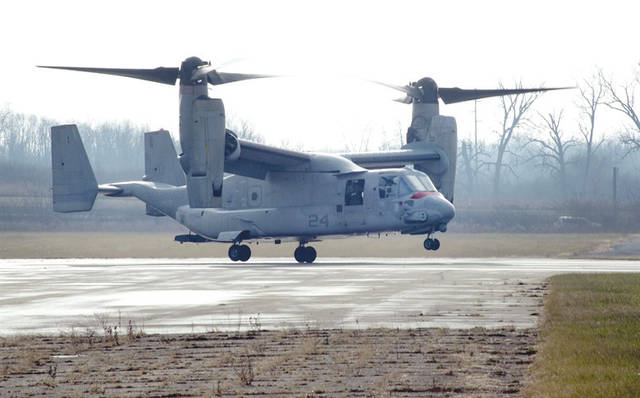
WRIGHT-PATTERSON AIR FORCE BASE — The Naval Medical Research Unit of Dayton (NAMRU-D) accepted Aircraft 24, a decommissioned Marine Corps V-22 Osprey tilt-rotor aircraft, for aerospace medicine research on Dec. 19.
“The MV-22 will be used to conduct static aerospace medical research in an effort to provide solutions toward preventing musculoskeletal injury to tilt-rotor aircraft crew,” said Lt. Cmdr. Matthew Doubrava, senior medical officer at NAMRU-D.
Along with researching prevention of musculoskeletal injury to tilt-rotor aircraft crew, Doubrava said that NAMRU-D will also be using the aircraft to study en route care to determine the most useful way to load and employ aircraft in that role.
Prior to the MV-22 arrival and landing in Area B, a team of NAMRU-D personnel participated in a foreign object damage walk to ensure the area was cleared of debris.
Delivered by the Air Test and Evaluation Squadron 21 from Patuxent River, Maryland, NAMRU-D commanding officer Capt. Rees Lee accepted the aircraft on behalf of NAMRU-D.
The MV-22 Osprey is a multipurpose tilt-rotor aircraft that has the vertical ability of a helicopter and the speed and range of a fixed-wing aircraft. With its rotor in a vertical position, it can take off, land and hover like a helicopter. Once in the air, the MV-22 can transform into a turboprop airplane capable of high-speed, high-altitude flight.
Although Aircraft 24 was used primarily for conducting developmental flight testing, the primary mission of the MV-22 is for transportation of troops, equipment and supplies from ships and land bases for combat assault and assault support.
Mark Hollady, MV-22 flight test engineer lead, stated the most important role of Aircraft 24 was to evaluate the MV-22 Ice Protection System in a natural icing environment. To undergo testing, the aircraft had underwent extensive modifications that included installing a flight test engineer control station, complex instrumentation system, and the latest generation components for the Ice Protection System. The external configuration of the aircraft was modified to represent a Marine Corps MV-22 on one side and an Air Force CV-22 on the other to allow ice accumulation characteristics to be measured simultaneously for both aircraft configurations during a natural icing test program.
Given the nickname “Chilly Willy” after the penguin cartoon character, the aircraft spent several winters for testing in Halifax, Nova Scotia from 2003-2006.
After spending time in Nova Scotia, Chilly Willy was then used for numerous testing programs such as GPS and avionics software resulting in the development and evaluation of many versions of flight controls and avionics software.
The United States Air Force School of Aerospace Medicine (USAFSAM) located next to the NAMRU-D, will also reap the benefits of the MV-22 Osprey and will utilize it for en route care training.
“The aircraft will be jointly beneficial to the research and training efforts conducted by NAMRU-D and USAFSAM,” said Lee.
NAMRU-D is a major Department of Defense medical research command and the home of the Naval Aerospace Medical Research Laboratory and the Environmental Health Effects Laboratory. As a subordinate command to the Naval Medical Research Center, NAMRU-D conducts aerospace medical and environmental health effects research to enhance warfighter health, safety, performance, and readiness.


